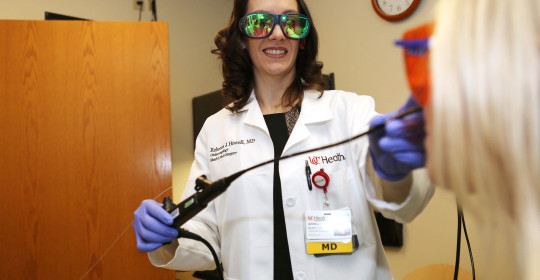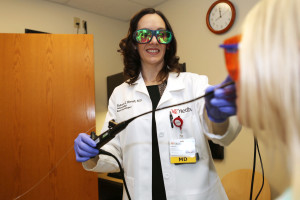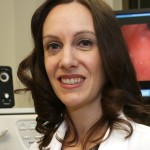
Integrating Laryngology and Speech/Language Pathology for Optimal Voice Care
Historically, voice patients have been evaluated by a physician and subsequently referred to a speech language pathologist (SLP) who may not work in the same facility, and who the physician may have never met.1 However, University of Cincinnati Medical Center is one of just a few academic medical centers nationwide to offer a state-of-the-art Voice and Swallowing program which combines the expert knowledge of laryngologists and SLPs. Along with innovative in-office procedures using leading-edge equipment, they are able to provide complete voice care for patients.
“It is also increasingly being seen that laryngologists who specialize in voice/swallow issues obtain better outcomes than those seen with generalists,” says assistant professor of otolaryngology Rebecca J. Howell, M.D. She cites Director of the Voice and Swallowing Center Sid Khosla, M.D. as a prime driver of the effort to offer multidisciplinary care, emphasizing that he has hired not only a voice/swallow laryngologist but also numerous SLPs.
The benefits of a collaborative approach include significantly reduced no-show rates for speech/language pathology, as patients are screened more appropriately and regard their treatment plan more seriously. A recent study found that attrition rates for behavioral voice therapy are thought to be between 16% and 65%.1 Voice therapy attendance has been shown to improve when patients are evaluated in a multidisciplinary voice clinic consisting of a laryngologist and speech language pathologist (SLP).1In addition to this team-based approach, the Voice and Swallowing Center offers a wide variety of office-based procedures. One example is video stroboscopy, which previously required patients to visit a separate department, have the test performed, and then visit the laryngologist again to have the results read. Now, the procedure is performed, interpreted, and a treatment plan established in a single visit. Other procedures, such as transnasal esophagoscopy (TNE), are performed in the office with the patients awake, as opposed to prior methods which required sedation. Awake procedures are significantly more convenient for patients, as well as avoiding the risks associated with general anesthesia.2 Finally, a new laser, the only one of its kind in the region, allows Howell to remove papilloma nodules in the office.
 This level of patient care is facilitated by both the expertise of staff and the most current technology. The Voice and Swallowing Center will soon be adding endoPortal, custom software and a dedicated server computer that will allow clinicians to remotely view stroboscopic, videoendoscopic, TNE, fluorographic, and fiberoptic endoscopic evaluation of swallowing (FEES) exams from any location in the hospital.3 Under the leadership of Khosla, this type of technology will continue to place the Voice and Swallowing Center at the forefront of the field.
This level of patient care is facilitated by both the expertise of staff and the most current technology. The Voice and Swallowing Center will soon be adding endoPortal, custom software and a dedicated server computer that will allow clinicians to remotely view stroboscopic, videoendoscopic, TNE, fluorographic, and fiberoptic endoscopic evaluation of swallowing (FEES) exams from any location in the hospital.3 Under the leadership of Khosla, this type of technology will continue to place the Voice and Swallowing Center at the forefront of the field.
References: 1. Litts JK, Gartner-Schmidt JL, Clary MS, Gillespie AI. Impact of Laryngologist and Speech Pathologist Coassessment on Outcomes and Billing Revenue. The Laryngoscope. 2015:1-4. 2. Shah MD, Johns MM. Office-Based Laryngeal Procedures. Otolaryngol Clin N Am 46 (2013) 75–84. 3. http://www.kaypentax.com/index.php?option=com_product&controller=product&Itemid=3&cid[]=94&task=pro_details. Accessed June 25, 2015.
Rebecca J. Howell, M.D.
Assistant Professor of Otolaryngology
513-558-4564
howellrb@ucmail.uc.edu


